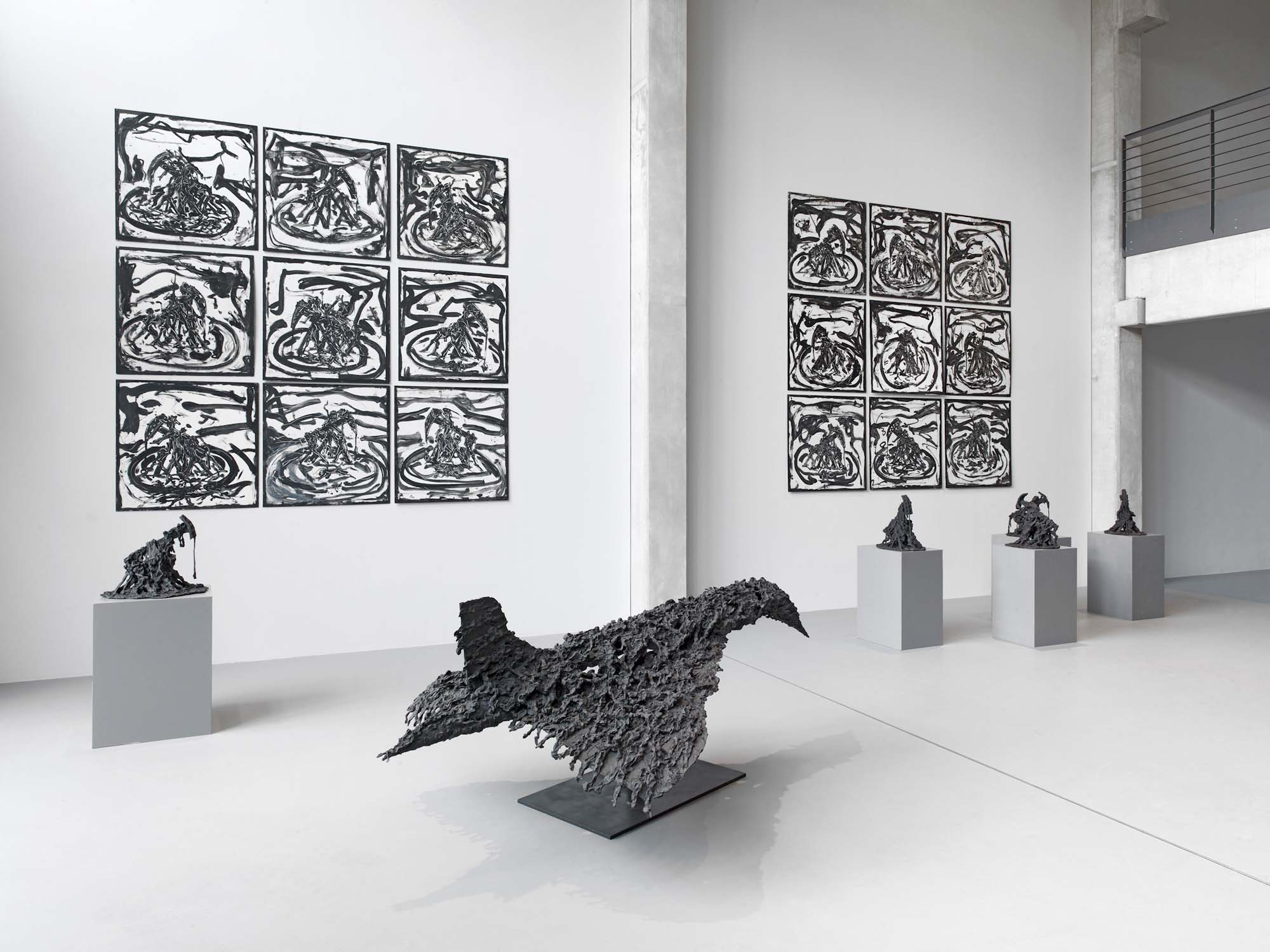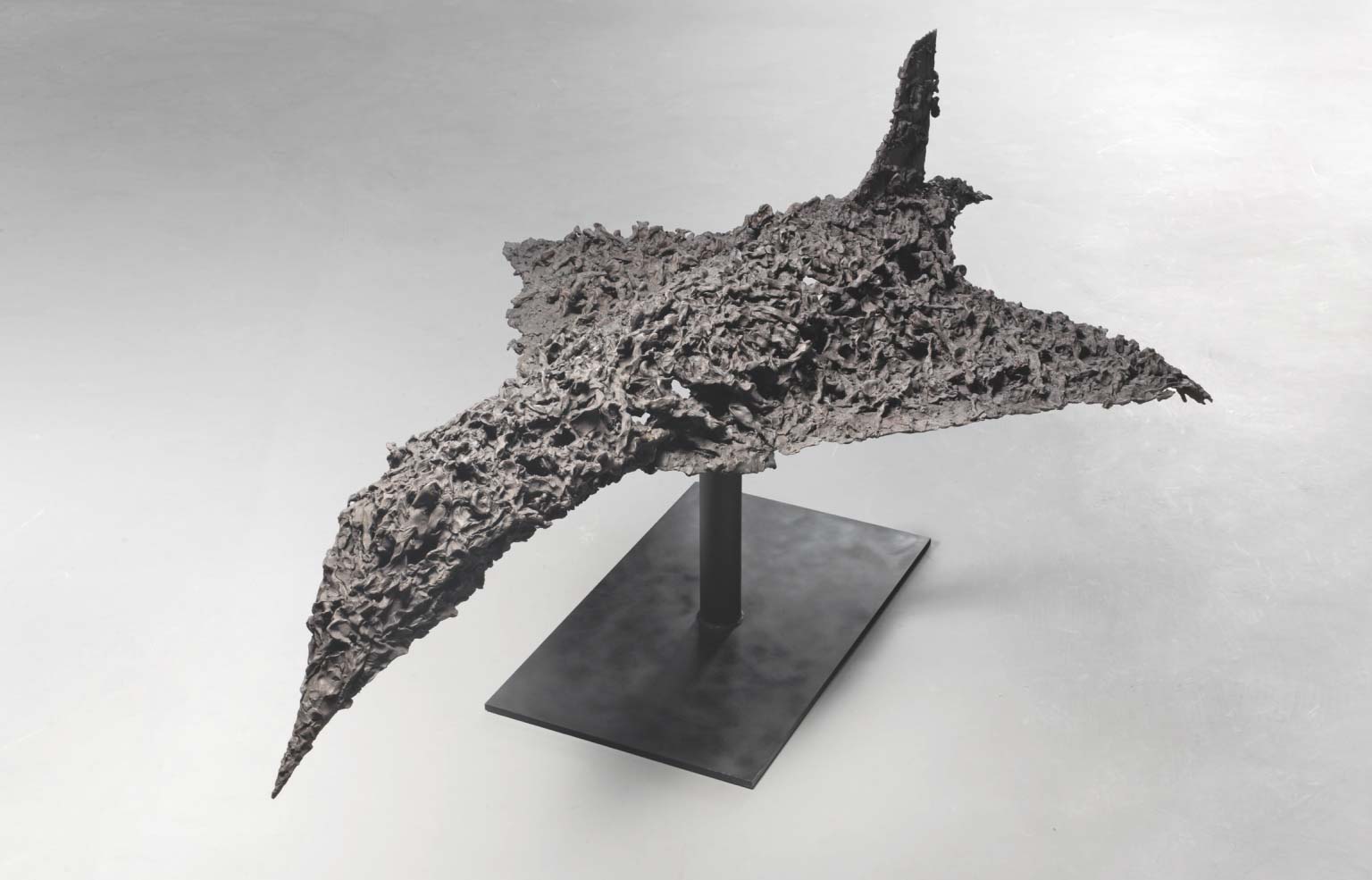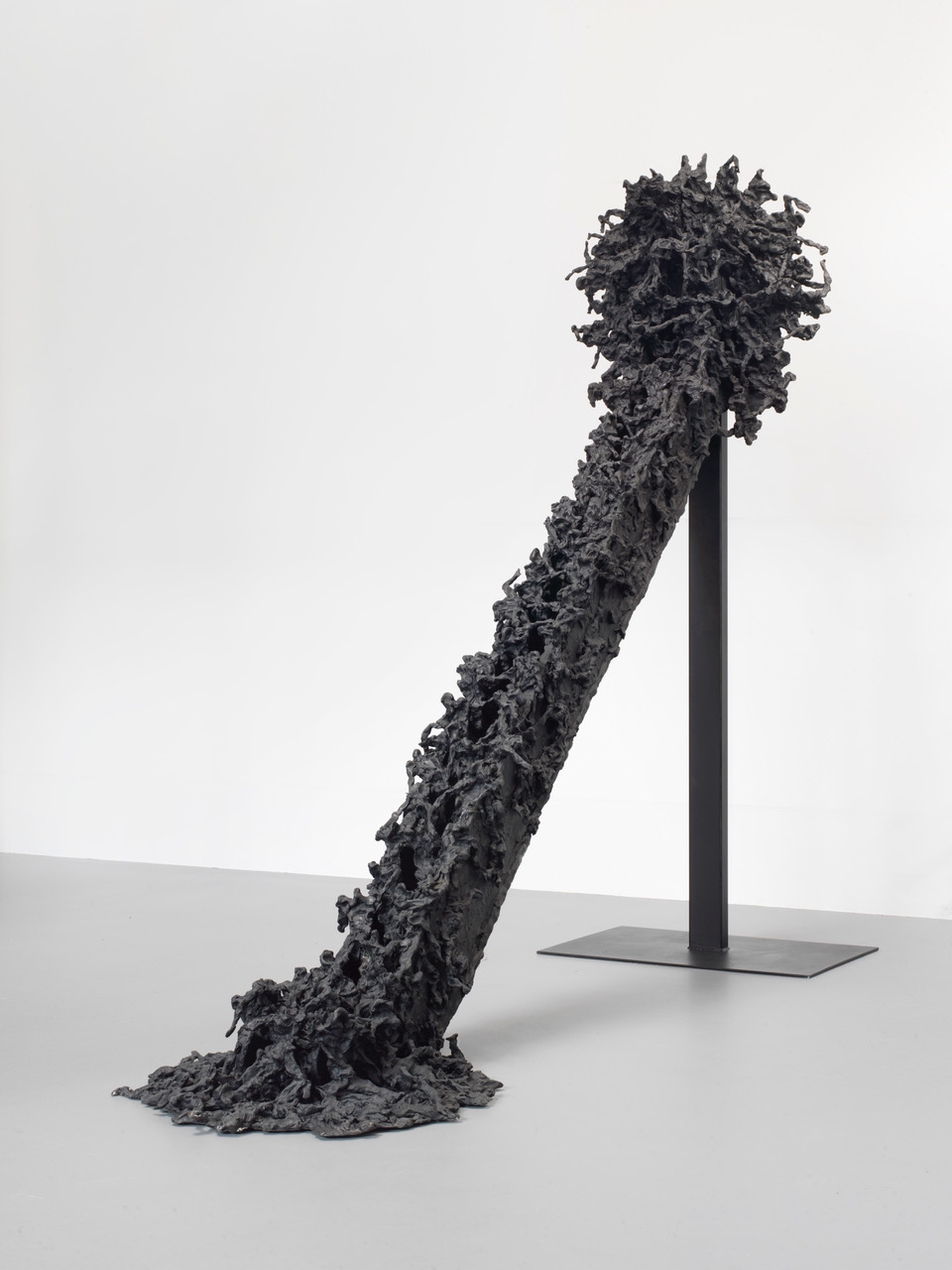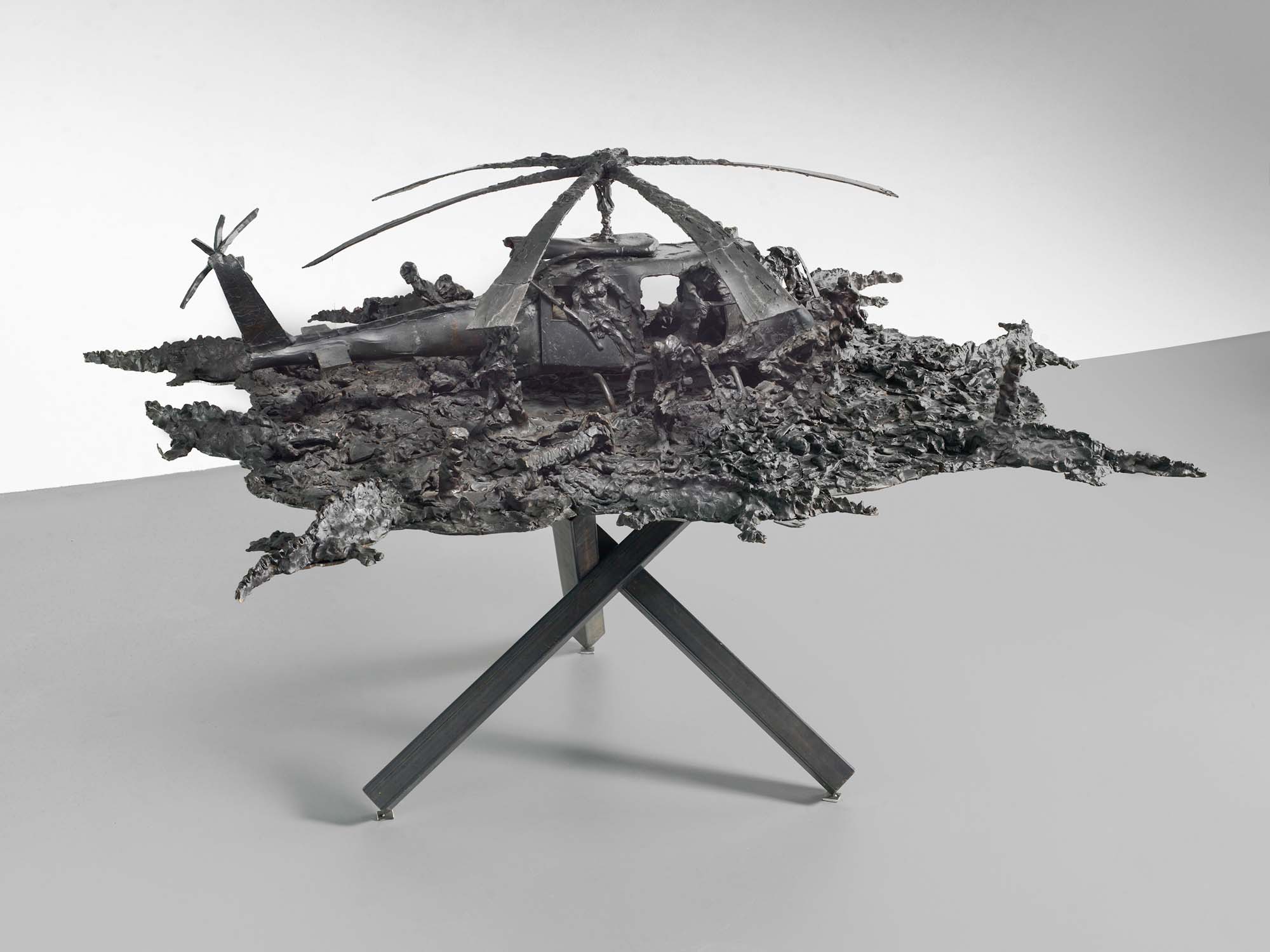
Ricard Larsson Exhibition 2018
Alles ist schwarz. Das Werk des schwedischen Künstlers Ricard Larsson wirkt wie eine Gerichtsverhandlung ohne Anklage und ohne Urteilsspruch – aber nicht ohne Humor.
Verhandelt wird das Leid und die Zerstörung, die die Menschheit dank ihrer Technologie in nie gekanntem Maßstab anzurichten in der Lage ist. Und auch das Groteske und Obszöne dieser Maschinerien findet dabei in der flirrenden, beunruhigenden Formenwelt Larssons suggestiven Ausdruck. „Look what they are doing!“, sagt Larsson mit einer Mischung aus Belustigung und Entsetzen im Hinblick auf die Scharen menschlicher Figuren, die seine Skulpturen bevölkern. Und sie tun eine ganze Menge: Sie springen aus brennenden Häusern, krabbeln wie Ameisen über überfüllte Züge und Rolltreppen, quälen und vernichten sich, verzweifeln.
Herausstechend dabei ist das Werk Island, eine Explosionswolke oder Atompilz, das, wie alle Werke Larssons, vielschichtige Referenzen an die Katastrophen unserer Zeit in sich trägt: Unter anderem den Gaza-Krieg, Fukushima und die französischen Atomtests im Pazifik. Doch in scheinbarem Gegensatz dazu drängt sich durch die verschlungenen, tropfenden und organischen Formen auch noch eine andere Assoziation auf, und zwar die eines tropischen Urwaldbaums. Wer ist der Mann, der diese seltsame Fusion von Natur und Technologie, Leben und Tod betreibt?
Ricard Larsson wurde 1953 in Stockholm geboren und studierte an der dortigen Kunsthochschule Malerei und Bildhauerei. Viele Jahre lebte und arbeitete er in seiner Werkstatt bei Florenz, bevor er mit seiner Frau nach Berlin zog, wo er sein Atelier in den Uferhallen bezog. Hier widmet er sich schon seit 20 Jahren der Entwicklung seiner Kunst und hat sich dabei sein eigenes Reich geschaffen. Perfekt sei er, schwärmt Larsson, auf seinen Arbeitsraum angesprochen, und weist auf das Licht hin, das durch die Deckenfenster des hallenartigen Atelierraums auf das Gewimmel aus schwarzem Wachs fällt. Tiefgrüne Pflanzen und ein paar Katzen bringen etwas freundliche Lebendigkeit hinein und fügen sich seltsam nahtlos in das katastrophische Geschehen ein.
Den Rhythmus seiner Arbeit an diesem besonderen Ort setzt für Larsson sein Material, vor allem das Wachs. Etwa fünf Minuten hat er Zeit, um dem Stoff seine Form zu geben, dann ist er hart. Bei näherem Hinsehen erkennt man den Fingerabdruck, den Larsson wortwörtlich in seinen Skulpturen hinterlässt. Die Spuren des Pressens und Knetens machen die kreative Intuition, die Larssons Arbeit leitet, für den Betrachter transparent. Die Zeit, um ein Werk abzuschließen, gehorcht dagegen anderen Gesetzen. Manchmal sind es bloß Stunden, manchmal Jahre, die es braucht, damit die finale Form erreicht ist.
Der letzte Schritt findet dann in der Werkstatt der Gießerei Noack statt, wo die Skulpturen mit Hilfe von Formsand in Bronze überführt werden. Fragt man Ricard Larsson nach der Motivation, die ihn zur plastischen Arbeit treibt, fallen seine Antworten weit weniger alarmistisch aus, als man in Anbetracht seiner katastrophischen Motive erwarten würde. „It helps to be in this“ sagt er und meint mit „this“ nichts weniger als diese unsere Welt und die menschliche Existenz darin. Eine Art Trost also? Sicherlich nicht nur, denn er legt durchaus Wert darauf, „obnoxious“, also anstößig oder widerwärtig zu sein, und sein tiefes Unbehagen angesichts der Weltlage mit der Betrachterin zu teilen; jedoch ohne dabei den Finger zu erheben oder als moralische Instanz aufzutreten. Vielleicht erklärt diese Haltung auch die organische Kreatürlichkeit, die Larsson seinen technischen Motiven verleiht. Und von da aus ist es zu dem pessimistischen Kurzschluss nicht weit, dass die dunkle Kehrseite unserer Zivilisation vielleicht Teil der oder zumindest unserer Natur ist. Die assoziative Vielschichtigkeit von Larssons Werk gibt jedenfalls viel Raum für Spekulation – auch was den Einfluss anderer Künstler auf sein Werk betrifft. Fragt man ihn danach, lächelt er allerdings nur und winkt ab: „No, no. It‘s all my fault.“
Text: Viktor Gallandi
"It’s all my fault”
The black human comedy of Ricard Larsson
Everything is black. The work by Swedish artist Ricard Larsson comes across as a trial without charge and without sentence – but not without humour. It is the suffering and destruction, which humanity is capable of causing on an unprecedented scale, thanks to its technology, that is on trial here. The grotesqueness and obscenity of these machineries are also reflected suggestively in Larsson’s whirring, unsettling world of shapes.
“Look what they are doing!” says Larsson, with a mixture of amusement and dismay and with regard to the crowds of human figures that populate his sculptures. And they are doing a great deal: they are jumping out of burning houses, crawling like ants across overcrowded trains and escalators, tormenting and destroying each other, they are desperate. The piece titled Island stands out in particular in this respect, an explosion cloud or mushroom cloud which, like all of Larsson’s pieces, carries multi-layered references to the catastrophes of our time: the Gaza war, Fukushima and the French nuclear tests in the Pacific Ocean. As if in contrast to this, however, a different image seems to be pushing its way through the intertwined, seeping and organic shapes, namely that of a tropical rainforest tree. Who is this man, who indulges in this extraordinary fusion of nature and technology, of life and death?
Ricard Larsson was born in 1953 in Stockholm and studied painting and sculpture at the academy of arts. He lived and worked in his workshop near Florence for many years, before he and his wife moved to Berlin, where he moved into his Uferhallen art studio. There he has been dedicated to the development of his art for 20 years now and has created his own domain in doing so. Larsson gushes that it is perfect, referring to his working space, and points out the light which is coming in through the ceiling windows of the hall-like studio room and falling on the teeming crowd made of black wax. Dark green plants and a couple of cats add a bit of friendly liveliness and, strangely enough, blend in perfectly with the catastrophic events.
The rhythm of Larsson’s work in this exceptional place is set by his materials, most notably wax. He has about five minutes’ time to give the material its shape before it solidifies. If you look closer, you can see the fingerprint that Larsson quite literally leaves in his sculptures. The traces of pressing and kneading make the creative intuition that guides Larsson’s work transparent to the observer.
In contrast, the time it takes to complete one of his pieces obeys different laws. Sometimes it takes merely hours, sometimes years, before the final form is found. The last step takes place at the Noack fine art foundry, where the sculptures are transformed into bronze with the help of foundry sand.
If you ask Ricard Larsson about the motivation that has driven him to sculptural works, his answers turn out to be much less alarmist than one would expect in view of his catastrophic themes. “It helps to be in this,” he says, and by “this” he means nothing less than this, our world, and the human existence within. Some sort of consolation, then? Certainly not just that, as he definitely makes a point of being obnoxious and shares his deep malaise with regard to the state of the world with the observer, although he does this without pointing fingers or behaving like a moral authority.
Perhaps this attitude also explains the organic creatureliness that Larsson bestows on his technical motifs. From here it’s easy to jump to the pessimistic conclusion that the dark side of our civilisation might be part of nature, or at least part of our nature. In any case, the multidimensional nature of the associations found in Larsson‘s works leaves a lot of room for speculation – as does the influence of other artists on his works, for that matter. If you ask him about it, however, he just smiles and waves the idea aside, saying “No, no. It’s all my fault.”



